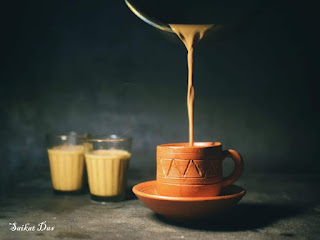Tea: The most loved word of the nation.
By: Priyanka Paul
Introduction:
India is one of the largest tea producers in the world, although
over 70 percent of its tea is consumed within India itself. India is one of the
top tea producers and consumers. A number of renowned teas, such as Assam and
Darjeeling also grows exclusively in India. The Indian tea industry has grown
to own many global tea brands.
 |
| PC: Saikat Das |
History of Tea in India:
The tea cultivation in India began in the nineteenth century by
the British. In the early 1820s, the British East India Company began
large-scale production of tea in Assam, India, of a tea variety traditionally
brewed by the Singpho people. By the turn of the century, Assam became the
leading tea-producing region in the world. India was the top producer of tea
for nearly a century, but recently, China has overtaken India as the top tea
producer due to increased land availability.
Indian tea companies have acquired a number of iconic foreign tea
enterprises including British brands Tetley and Typhoo. The major tea-producing
states in India are Assam, West Bengal, Tamil Nadu, Kerala, Tripura, Arunachal
Pradesh, Himachal Pradesh, Karnataka, Sikkim, Nagaland, Uttarakhand, Manipur,
Mizoram, Meghalaya, Bihar, and Orissa.
India consumes a lot of tea than coffee. In India, tea is made both
at home and outside, Tea stalls in India plays a vital role in the urban
areas, In India tea, is used as welcome drinks in every house, and it is a very
common beverage that everyone offers to their guests, tea in India is mainly
consumed with both milk and sugar.
 |
| Tea Garden at Kaliabor, Assam PC: Subhankar Banerjee |
Types of Tea:
There are around 12 popular varieties of tea in India, in this blog
we will highlight about Orthodox Tea, Yellow Tea, Green Tea, and White Tea.
From green tea to yellow, and yellow to white, teas are chock full
of flavonoids and other health benefits. Studies have found that teas may help
in various ways, such as some teas helps using cancer, heart disease, and
diabetes; encourage weight loss; lower cholesterol, and bring about mental
alertness. Tea also appears to have antimicrobial qualities.
Now let us learn about a few varieties of tea and their health
benefits:
Orthodox Tea:
Orthodox tea refers to the tea which is made or processed using
the traditional method. Orthodox tea is generally bright and brisk and has a
multilayered flavor profile. Orthodox Tea is produced using the traditional
methods of Tea production which include plucking, withering, rolling,
oxidation, and drying.
Benefits:
· It is high in
Antioxidants, antioxidants help to neutralize damaged cells which help us to
look and feel better.
· Helps prevent
Cardiovascular Disease
· Loose-leaf teas retain
Authentic Taste and are comparatively richer in flavor and color.
Yellow Tea:
Due to huge tea varieties, it might be hard for one to choose one
particular type. Each one has a specific taste and texture. Here’s why
Yellow tea is special, Yellow tea is not just healthy but also savory, which
makes it different.
So what is Yellow Tea? Yellow tea is a variety of tea that is
native to China. This variety of tea is quite expensive and is not produced
everywhere. The process of making this tea is similar to that of green tea but
with an added step, which involves encasing and steaming the tea. As the tea
oxidizes at a slower rate, it gets the mellow taste. This tea has gained
popularity because of its smooth and silky texture, and the various health
benefits it offers.
Benefits:
· Strengthens the Bones
and Teeth, Drinking yellow tea can lower joint paint also.
· This can help in
preventing brain strokes. It is especially good for old people.
· The antioxidants present
in the yellow tea can help your brain function better.
· A cup of this tea can
increase the appetite and bring back your energy level.
· Drinking yellow tea can
help reduce bad cholesterol within the body while promoting HDL levels.
· People suffering from
diabetes can help themselves by drinking yellow tea that tends to control
sugar levels by itself.
 |
| Yellow and Orthodox Tea PC: Subhankar Banerjee |
Green
Tea:
Green Tea is considered to be one of the healthiest
beverages. Made with steamed tea leaves, green tea’s antioxidants are loaded
with many health benefits. Regularly drinking green tea can help you lose
weight and reduce your risk of several diseases, including diabetes, heart
disease, and cancer.
Benefits:
· Improves brain function.
· Helps in fat loss by boosting the metabolic rate.
· Contains healthy bioactive compounds.
· It is rich in polyphenols which help in reducing inflammation and fights cancer.
· Its antioxidants properties may lower the risk of cancer such as breast cancer, prostate cancer, and colorectal cancer.
· It protects the brain from aging, helps in preventing diabetes, reduces bad breath, etc.
· Improves brain function.
· Helps in fat loss by boosting the metabolic rate.
· Contains healthy bioactive compounds.
· It is rich in polyphenols which help in reducing inflammation and fights cancer.
· Its antioxidants properties may lower the risk of cancer such as breast cancer, prostate cancer, and colorectal cancer.
· It protects the brain from aging, helps in preventing diabetes, reduces bad breath, etc.
 |
| Green Tea PC: Priyanka Paul |
 |
| PC: Priyanka Paul |
White
Tea:
White tea is known to be one of the most delicate tea varieties
because it is so minimally processed. White tea is harvested before the tea
plant’s leaves open fully when the young buds are still covered by fine white
hairs, hence the name “white” tea. White Tea is made from the camellia Sinensis
plant. Our white tea is simply allowed to wither and dry in a carefully
controlled environment, it is essentially non-oxidized and it is the least
processed which results in the most delicate tea. White tea is not exposed to
artificial heat, the leaves are fresh-from-the-garden tasting tea, white teas
are still revered today for their delicate, beautiful aromas and flavors. Most
white teas are still handpicked and hand processed, making them a truly
delicious beverage to sip. Also, there are different types of white tea, such
as
·
BaiHao Yin Zhen (Silver
Needle)
·
BaiMudan (White Peony)
·
Darjeeling White Tea
Benefits:
·
Reduce the risk of heart
disease.
·
Protect your teeth from
bacteria.
·
Compounds in white tea
may protect against osteoporosis.
·
Compounds in white tea,
help protect your skin from both internal and external aging.
 |
| White Tea By: Kamal Teron |
NOTE:
Tea plays a vital role in health, thus
if you want to have a healthy cup of tea, just cut out the sugar of it and
add honey instead.
As we love our chai a lot and would like
to have it at any time of the day, so there are also a few cautions to remember
before having tea, such as:
Ø Avoid drinking tea on empty stomach; prolonged consumption of tea
on an empty stomach can cause acidity and loss of appetite.
Ø Do not reheat tea; heating tea, again and again, can make it
acidic and also destroy the real taste of the leaves.
Ø Never have your tea as the first thing in the morning. It slows
down metabolism curbs, natural hunger, and can eventually lead to weight gain,
and hence, before drinking a cup of tea it is always good to have a glass of
water.
Ø Avoid consuming extremely hot tea: drinking extremely hot tea will
irritate your mouth, throat, esophagus, and stomach. It found in studies that
drinking tea over 69 degrees Celsius can cause damage to your stomach.
Ø Having an excess of tea might have a mild diuretic effect, due to the
presence of caffeine in it.
Ø It is important to limit your cups when pregnant, it can harm in
the growth process of the fetus.
Conclusion:
Tea in India is not just a beverage, it’s a religion, and it is
one of the most common drinks for people of all ages. Tea culture in India is
flourishing and to add glamour in it, you can find big restaurants coming
up with innovative ideas to increase their sales. Chai Bar, Chai Pe
Charcha, Chai Adda, Chai Point, Keseria Chaiwala, Chai Break, etc are very
well known to all the tea lovers across the nation.
Edited by: Subhankar Banerjee
Source: Google, Wikipedia, and Personal Research




Nice
ReplyDelete